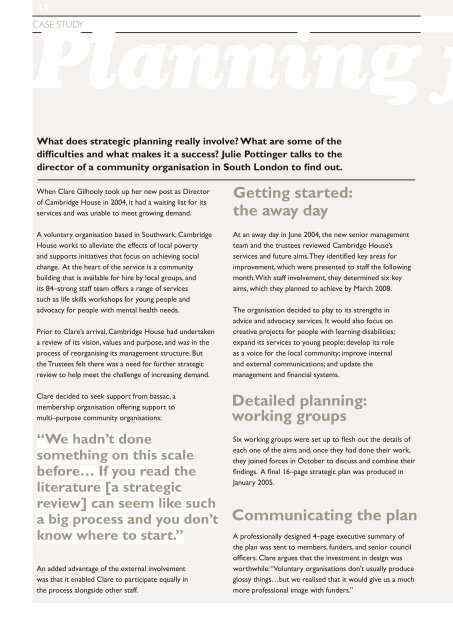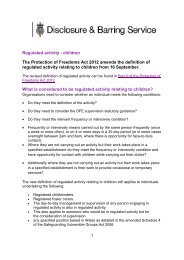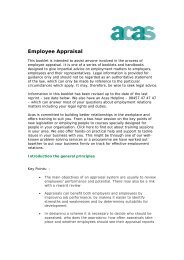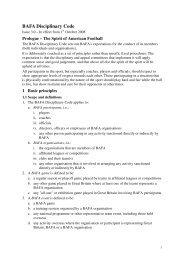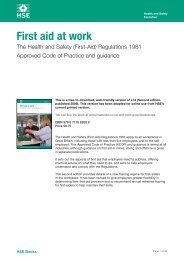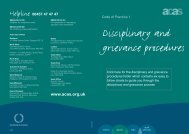Achieve More 2 - National Council for Voluntary Organisations
Achieve More 2 - National Council for Voluntary Organisations
Achieve More 2 - National Council for Voluntary Organisations
Create successful ePaper yourself
Turn your PDF publications into a flip-book with our unique Google optimized e-Paper software.
14 15<br />
Planning<br />
CASE STUDY<br />
<strong>for</strong> success<br />
What does strategic planning really involve What are some of the<br />
difficulties and what makes it a success Julie Pottinger talks to the<br />
director of a community organisation in South London to find out.<br />
When Clare Gilhooly took up her new post as Director<br />
of Cambridge House in 2004, it had a waiting list <strong>for</strong> its<br />
services and was unable to meet growing demand.<br />
A voluntary organisation based in Southwark, Cambridge<br />
House works to alleviate the effects of local poverty<br />
and supports initiatives that focus on achieving social<br />
change. At the heart of the service is a community<br />
building that is available <strong>for</strong> hire by local groups, and<br />
its 84–strong staff team offers a range of services<br />
such as life skills workshops <strong>for</strong> young people and<br />
advocacy <strong>for</strong> people with mental health needs.<br />
Prior to Clare’s arrival, Cambridge House had undertaken<br />
a review of its vision, values and purpose, and was in the<br />
process of reorganising its management structure. But<br />
the Trustees felt there was a need <strong>for</strong> further strategic<br />
review to help meet the challenge of increasing demand.<br />
Clare decided to seek support from bassac, a<br />
membership organisation offering support to<br />
multi–purpose community organisations:<br />
“We hadn’t done<br />
something on this scale<br />
be<strong>for</strong>e… If you read the<br />
literature [a strategic<br />
review] can seem like such<br />
a big process and you don’t<br />
know where to start.”<br />
An added advantage of the external involvement<br />
was that it enabled Clare to participate equally in<br />
the process alongside other staff.<br />
Getting started:<br />
the away day<br />
At an away day in June 2004, the new senior management<br />
team and the trustees reviewed Cambridge House’s<br />
services and future aims. They identified key areas <strong>for</strong><br />
improvement, which were presented to staff the following<br />
month. With staff involvement, they determined six key<br />
aims, which they planned to achieve by March 2008.<br />
The organisation decided to play to its strengths in<br />
advice and advocacy services. It would also focus on<br />
creative projects <strong>for</strong> people with learning disabilities;<br />
expand its services to young people; develop its role<br />
as a voice <strong>for</strong> the local community; improve internal<br />
and external communications; and update the<br />
management and financial systems.<br />
Detailed planning:<br />
working groups<br />
Six working groups were set up to flesh out the details of<br />
each one of the aims and, once they had done their work,<br />
they joined <strong>for</strong>ces in October to discuss and combine their<br />
findings. A final 16–page strategic plan was produced in<br />
January 2005.<br />
Communicating the plan<br />
A professionally designed 4–page executive summary of<br />
the plan was sent to members, funders, and senior council<br />
officers. Clare argues that the investment in design was<br />
worthwhile: “<strong>Voluntary</strong> organisations don’t usually produce<br />
glossy things…but we realised that it would give us a much<br />
more professional image with funders.”<br />
Implementation<br />
and review<br />
Management and staff are now designing each team’s work<br />
programme to include one or two of the aims. Clare<br />
also intends to update the strategic plan every year.<br />
“Our plan isn’t perfect,<br />
but I’ve realised that<br />
you should do the bits<br />
that are achievable <strong>for</strong><br />
you at the time.”<br />
In September 2005, Clare ran a half–day<br />
session with trustees to review how the<br />
plan’s implementation was going.<br />
“It was reassuring to<br />
find that about 80%<br />
of the first–year goals<br />
had been achieved<br />
within six months.”<br />
Benefits<br />
As a result of its strategic review, Cambridge House<br />
has developed a Time Bank, a Residential Care<br />
Advocacy Service, expanded into Community Care<br />
Law, created two new services <strong>for</strong> people with learning<br />
disabilities and increased the capacity of their Play and<br />
Respite Care Scheme. It has also developed a ground<br />
breaking Tolerance and Diversity project with young<br />
people. Further, the organisation now focuses more<br />
on user involvement and holds more frequent events<br />
designed to involve staff in the organisation’s future.<br />
Reflecting on the process, Clare is pleased so many<br />
people took part and signed up to the same direction.<br />
“It has helped us to grow and we’re all clearer about<br />
where we’re going.” She feels that the support they<br />
received from bassac was vital to the success of the<br />
process. The organisation facilitated meetings, offered<br />
phone support and commented on drafts of the plan.<br />
As Clare explains,<br />
“It was having an external<br />
person that made the<br />
difference. A critical friend<br />
will say some painful things<br />
you need to hear in a way<br />
you can handle it.”<br />
Lessons learned<br />
These are the key lessons Clare feels she<br />
learned from the experience:<br />
1. Get an external partner involved who can<br />
play the role of ‘critical friend’<br />
2. Make sure someone internal drives the process<br />
3. Don’t do it all yourself—set up one or<br />
more working groups<br />
4. Communicate your plan to your stakeholders<br />
5. Get the support of your trustees<br />
6. Set a date to review progress<br />
7. Be realistic—just do what you can!


